Glitch
Forum Replies Created
- AuthorPosts
-
My suggestion for anyone collecting these vintage Beocord units is <snip>
I can’t argue with that suggestion. The only thing left to think about is spare parts. I would like to keep a spare set of belts and rubber wheels on hand. I am hesitant to buy them if there is a good chance that they will degrade before I have a chance to use them. I am weighing this against the possibility of the supply of replacement parts drying up.
I am thankful that there are quality parts available right now. I am also realistic about that at some point in time this will not be the case.
And yet some belts seem to last forever: I have a Thorens turntable that has a 20 year-old belt that is still perfectly operational.
Yep. That is what makes this such a difficult topic.
Glitch
Nice work. Really clean 4k you have there! I can’t wait to work through my BM4k. I have a BG4002 with CD4 built in and can’t wait to get the duo playing together one day.
Thanks! Don’t forget to post pictures when you get your duo working. I hope someday to have the same combo but am still waiting for the right turntable to come along.
Glitch
Most companies consider speculation and rumors about their upcoming products as a positive thing. It is arguably better than the alternative of nobody caring if you are making new products.
Usually the truly sensitive product information is carefully controlled as a trade secret or with NDAs. I certainly hope that none of the employees, dealers, or possibly press, leaked something that they shouldn’t have.
One positive thing about living in the age of deep fakes is that even if something sensitive IS leaked, nobody will know if it it real or not ;-).
Glitch
The camera guys seemed to be concerned about stickiness versus degrading into goo. I’m not sure that any of them are able draw a meaningful conclusion without an actual comparison test. For example, they would have to have two lenses that were manufactured at the same time, then use one and store the other. This would be the only way that they could “know” that the difference in stickiness was due to handling. However, they still could come the wrong conclusion. Maybe the any difference in stickiness is due to incrementally removing the sticky substance on the handled lens versus it building up on the stored lens. Both items could have actually degraded the same amount, but “stickiness” is simply a poor metric to use for judging degradation.
Similarly, to make any real judgements about belt life, one would need to have two decks with the same parts installed. One deck would need to be used and the other not. A meaningful conclusion could be made if the belts on one of the decks held up better than the ones on the other. Otherwise, I don’t see how any definitive statements can be made.
The closest I can come to a meaningful experiment is with the rubberized coating on a computer mouse. Many years ago, I set up two office workstations, one for me and another for my wife. They both had the same keyboard, mouse and monitor (all purchased at the same time). I use my workstation daily, my wife uses hers very occasionally. The rubber coating on my mouse turned into a sticky mess, the coating on my wife’s mouse turned into a hard substance. Neither is anything like when they were new. I think I can make a meaningful statement about the coating on this particular model of mouse. I don’t think extrapolating this experience to anything else is necessarily meaningful.
One commonly believed theory (backed by science) is that every rubber part degrades somehow. The degradation clock starts when it is removed from the mold. The nominal speed of degradation is based on the composition and process used to manufacture the part. One can speed up or slow down the clock based on the environment or usage, but the degradation is inevitable.
The more I think about this the more questions that I have… For example, how important is it to buy a freshly manufactured belt? Buying from old stock would be problematic if the belts degrade mostly from not being used. Conversely, it wouldn’t be so much of a problem if the belts degrade mostly from usage.
Glitch
I did a bit more research and found that the correct term for the phenomena is “rubber reversion”. However, I think the term “goo-ification” is more fun ;-).
There seem to be many theories about what is going on. Many of them are based on the supposition that the polymer stabilizing additives migrate out of the rubber. I’m having a hard time conceptualizing how a working the rubber would slow the process versus keeping it in a state of stasis. There is a group of vintage camera enthusiasts that swear by the “use it or lose it” theory when it comes to rubber parts on cameras. Perhaps the rubber should be considered a viscous mixture and working it keeps everything mixed-up appropriately?
Regardless, I’ve already gone deeper down this rabbit hole than I intended. I’m still hoping that someone can shed some light on the original question.
Glitch
Poor storage conditions might accelerate the degradation of the belts, but I don’t think that it is the primary cause of goo-ification. I bought my Beocord new and it has spent its entire life in a climate controlled, living space. Regardless, I ended up with goo.
This issue is not unique to B&O. I’ve read similar stories for many other brands of equipment. The common cause has to be in the base material or in the manufacturing process of the belt. Who knows, maybe all of the goo-belts come from the same plant.
I’m hoping that they have made progress on the longevity of the belts. I believe that they have improved the formulation for other issue prone parts like foam speaker surrounds. It would be a real shame if the plastics industry reserved the “forever materials” strictly for disposable items like water bottles and soda straws. (yes, I know that they are different classes of plastics)
Glitch
I do know that as long as the machine is used every now and then, causing the belts to expand and contract, that reduces the chances of “gooing”.
I’d like to learn more about this. Can you provide any further details about why this would be the case?
I’ve always assumed that the belts degrade due to a process (like oxidation) that either causes the polymers to break down (into “goo”) or form a “new/modified” substance that is less elastic (cracked, brittle belts).
My motivation for having a better understanding of this is to help with a long term preservation plan for the equipment. For example, if it is inevitable that belts will turn to “goo”, it might be prudent to remove them before placing the equipment into storage. An analogy would be removing the alkaline batteries from a vintage toy, draining the gas from an antique car that won’t be driven for a while (or the swapping out the foam inside certain active speakers). I recently pulled apart a vintage computer where the CMOS battery leaked and corroded the nearby circuit board traces into green dust. Had I foreseen this, I’d still have a working computer.
Glitch
The pentagon form would give the option to use 2 penta’s at the both sides of the original Penta
Something like this?
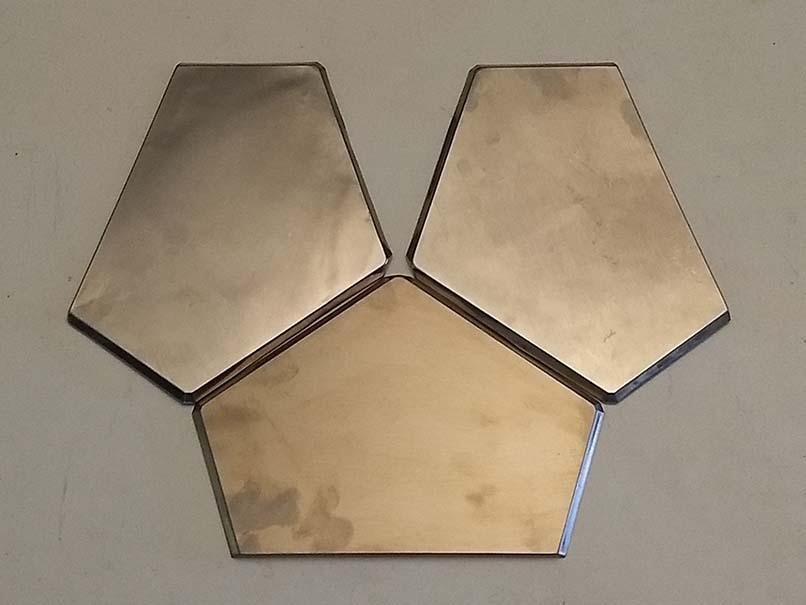
Glitch
Check out MiniDSP.com. They likely sell something that would get you to where you want to go. You may find out that when you consider the cost of the speaker equipment (DSP’s, amps, new enclosures, etc.), the necessary test equipment, and the value of your time, that it would be cheaper to just buy the ’50’s ;-). However, I suspect that, in this case, the journey is more important than the destination.
Have you considered doing the project in stages (with each stage having very specific goals)? For example, you could multi-amp and DSP crossover one set of Pentas to make them ultra-linear frequency response. You could also leave the Pentas untouched and do an 6-speaker room correction. At some point you would combine all that you learned in the earlier stages.
I’m looking forward to hearing about whatever you decide to do.
Glitch
I’m certainly not questioning the suitability or performance of the beoparts-shop belts. My assumption is that they are the highest quality part that is available.
My question was related to a design choice. Material science has made great progress in the decades between when the belts were originally designed and now. The new belts could have been specified using the original rubber formulation or something newer. I wouldn’t consider either choice to be “wrong”. I’m just curious about which choice was made.
Glitch
I did mine ten years ago and it just needed a new set of belts and a drop of oil here and there, always a good idea while it’s in bits and pieces.
How is it working now? Was the “drop of oil” added to the sintered bearings?
The motor does look similar to the Beocord 6000/8000 one but is it the same? How are the two speeds obtained?
Two speeds could be obtained by varying the voltage to the motor.
It’s something I will do when the time comes more out of interest than anything else…
It seems like the tricky part is figuring out how long it can be run before any permanent damage is done. Wouldn’t it be “too late” if the issue was found during some sort of performance testing?
If you decide to go that route I would be interested in hearing your results.
My plan is to buy another Beocord to experiment with. BC800x’s that need some TLC are readily available. I’d rather make any mistakes on a something that is already broken and less rare/collectable than the BC9000. I’ll post results when I make progress.
Glitch
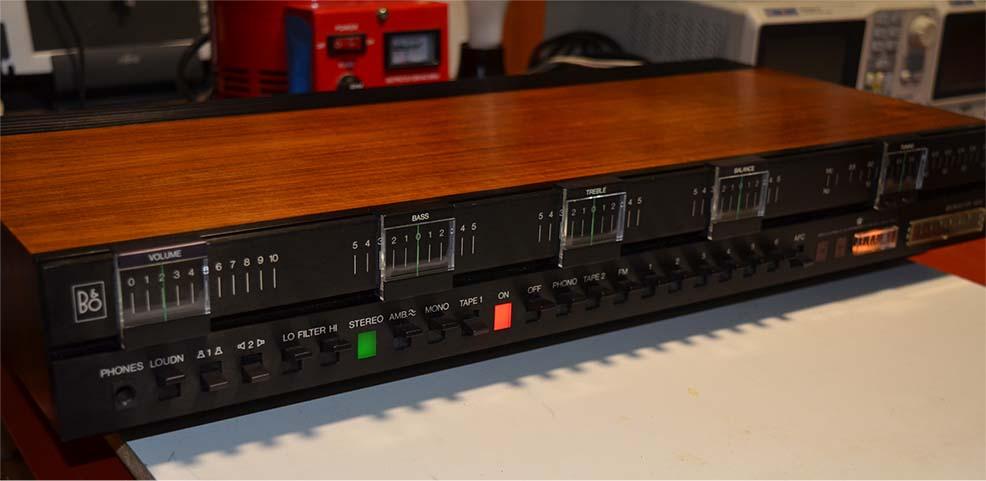
I just finished a refresh of this Beomaster 4000. This receiver was a good example of why one shouldn’t just grab a spray can of “contact cleaner/lubricant” and spray indeterminately to fix a noisy potentiometer or switch. Whatever product the previous owner used seeped everywhere inside the receiver then turned into a hard waxy substance. Fortunately, I was able to fully disassemble the receiver and clean the “gunk” out of the chassis, sliders and switches.
My plan for the receiver is to pair it with four Braun speakers from the same era. Braun speakers are actually somewhat rare in the US. I like to assemble systems with a theme. This will be my “70’s Euro-system”. I’m guessing that most of the forum members would just call it a “70’s system” 😉
I’m looking forward to experiencing the Ambiophonic feature. Does anyone have suggestions for era-appropriate recordings that highlight this feature?
Glitch
I found some more pictures where I took a Beocord 8002 motor assembly apart and photographed it next to the Beocord 9000.
Thank you very much for posting the pictures. Based on your pictures and some other information posted by Beolover, it looks like this is a reasonably straightforward job.
I wonder if any of the Beogram bearings sold at beoparts-shop are the same size? The motors certainly look similar. Has anyone measured/checked this already? Obviously, new bearings would be better than refurbished bearings if they are available.
Here is my pressure lubricator, if you need some ideas.
Here is what I came up with using what I had on-hand.
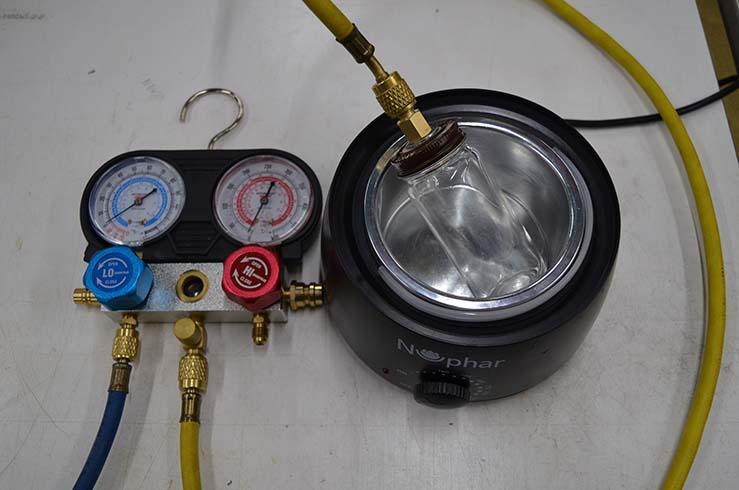
I can pull a very good vacuum and hold it for a few days. The blue hose goes to a HVAC vacuum pump. I plan to heat the bearings and oil. I don’t know if this will make a significant difference, but it couldn’t hurt.
Glitch
Option 2, running the motor by continually trying to keep it wet doesn’t sound like a good idea to me.
I haven’t done anything with those parts other than treating them with some synthetic oil.
We may be talking about the same process here. What I’m calling “wet” simply means adding a small amount of oil to the shaft/bearing interface. “Dry” would be relying exclusively on the oil that is impregnated in the bearing. I would consider a mechanism that is maintained by adding oil to a felt washer to be “wet”.
Many say that the downside to running a bearing “wet” is that it attracts contaminants that cause extra bearing wear. This might be a necessary evil compared to running a bearing with a worn/damaged surface that might not be getting oil from the reserves in the bearing. Neither choice is appealing.
I do have a concern about damaging the motor when disassembling it. For me, it is a hard decision because the motor seems to be operating very well. I try to avoid the self-inflicted injuries/problems whenever possible. Also, I try to not leave “technician tracks” when I work on something.
The motor cover is held in place with three bent tabs. I’ve tried to remove it, but it quickly became apparent that I wouldn’t be able to do so without damaging the case.
I haven’t seen any videos/pictures of this particular motor being disassembled. My next thought is to buy a “parts machine” to experiment on.
Do the Beocord 8000’s use the same motor as the the BC9000?
You make an interesting point about testing the motor. I’ll have to think about how to do this. I have a precision encoder left over from a robotics project that might be perfect for this.
You talked about testing your motor rebuilds. Have you gone back from time to time to check to see how well your rebuilds are aging?
Glitch
I was thinking motor bearings as I read it but I see that you are talking about the bearings on the capstan bearing.
I was considering ALL of the sintered bearings, but didn’t convey it very well. The first part of the question had to do with the best way, in general, to lubricate the bearings. I planned to ask a follow-up question on how to get the bearings out of the motor if it was deemed necessary. I also referred to the clutch bearings incorrectly as “idler shaft” bearings.
I am hoping to learn about other’s experience with various lubrication methods. I suspect that many of these machines were serviced/restored 15, or so, years ago. By now it should be clear what worked and what didn’t.
I assume that most everything that I’m doing to my machines is old news and was discussed decades ago. I’ve tried searching the archives of this (and other) forums for info. What I didn’t find much info on is: 1) the long term performance of the fixes and 2) the idea to swap the higher load bearing with the lower load bearing.
I’ve started working on cobbling together a small vacuum chamber. I think I figured out how to make a good connection to my vacuum pump with parts that I have on-hand.
My gut feel is to try option #3 above for the capstan/clutch and #2 for the motor unless someone has a compelling argument for one of the other options.
Glitch
Based on the info above, I decided to revisit the lubrication of the supply and take-up reels on my BC9000. Here is a close-up of the cap and spindle.
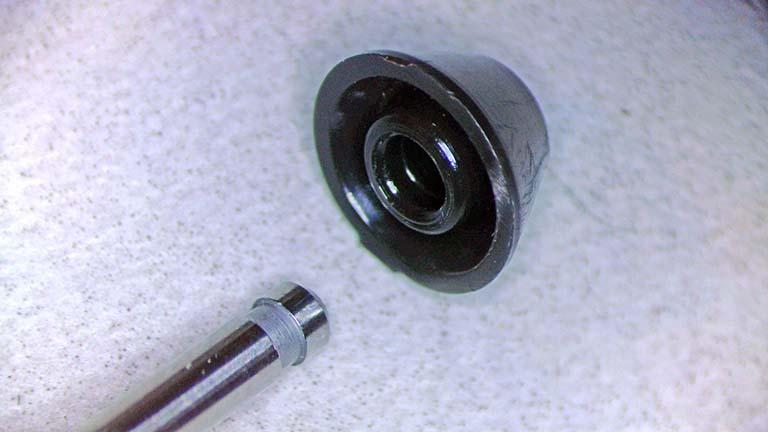
I noticed that the original lubrication was an amber colored, medium density grease. The grease on the shaft itself was hard to identify, but there was a small amount of grease in the groove of the cap that looks original and is not between moving parts. This is a bit odd since the service manual calls for Floil on the shaft. In researching this, others have also described grease at this location.
I wonder if the difference in lubrication was a running change, an oversight in the manual, or something else. I doubt that it really matters as long as the tape deck works reliably.
Glitch
I’m glad to hear that you figured out the issue. I wouldn’t have guessed that particular thing was your problem.
The markings on those Piher pots is difficult to read. One tip that I have is to place the components in a block of foam that is marked for the value.
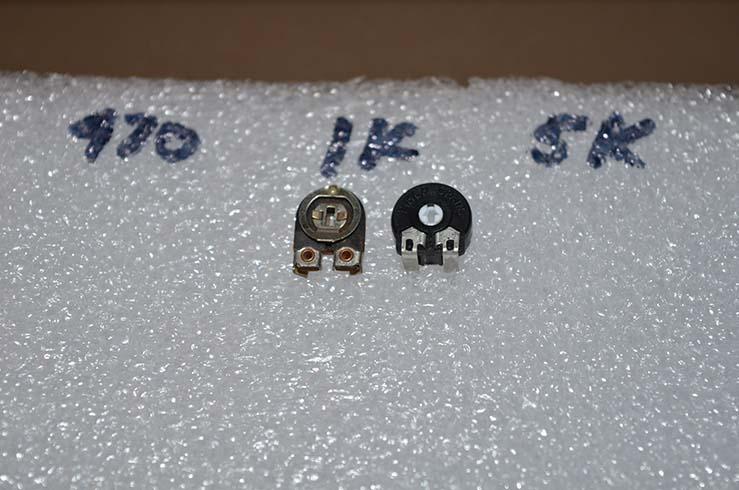
I like to test all of the new components before I install them. After they are tested, I stick them in the foam. This makes the re-cap/re-pot procedure go faster. I’ve also found new parts that are technically “in spec”, but are so marginal that I wouldn’t want to use them.
I also mark and stick the old components in the foam when I remove them. This makes it easy to test the old components to get an idea of how well they have aged.
BTW, the adjustment for the signal strength is one that you could get away with adjusting without instruments. Tune between strong and weak stations and adjust until the display gives a behavior that you like.
Glitch
March 11, 2023 at 5:32 pm in reply to: Is it ok to substitute a polarized cap for a non-polarized cap in the output amp #17336In general, it is not a good idea. If you are stuck, use two polarized caps in series to make a non-polarized equivalent. You could also use a different value non-polarized cap. I’ve tried both of these solutions as a stop-gap until the correct part arrived.
Glitch
Did you test the amp separately on a bench setup? Was the amp working OK before the recap?
Posting some high resolution pictures of your board might be helpful.
You were on the right track comparing the properly operating channel to the channel with the issue.
Glitch
Now that I think about it, it isn’t too much of a shame since I’ve already had fun working on it and learned some new things in the process. Also, I now have a solid machine on which to experiment with my crazy ideas. Hacking this into something unique may provide more entertainment than doing a restoration.
Glitch
- AuthorPosts
